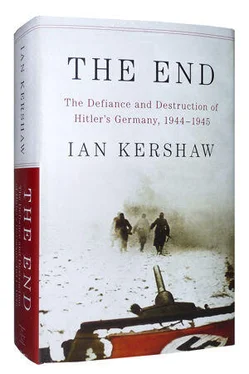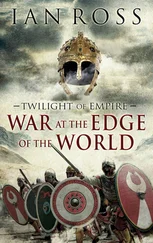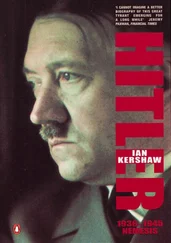Hitler had established a corps of NSFOs within the High Command of the Wehrmacht in December 1943 and placed it under the charge of General Hermann Reinecke. Its task was to instil the Nazi spirit into troops who, he feared, were being affected by subversive Soviet propaganda. For Hitler and the regime’s leadership, breathing fanaticism into the troops was the road to victory. 97There was little liking for the new institution among the officer corps, and the NSFOs had a hard time gaining acceptance. The failed uprising of July 1944 drastically changed the situation. 98It was not that the NSFOs were now greeted with open arms by most soldiers, or that their message was warmly welcomed and taken to heart. On the contrary: their presence often remained resented, and their pep-talks frequently still fell on deaf ears. Even so, much of the Wehrmacht’s mass base was still potentially receptive to Nazi ideals, since around a third of ordinary soldiers were or had been members of some Party affiliate. 99
In any case, the new circumstances meant that there was now no protection against the extended deployment of these military missionaries of Nazi ideology. Their chief, General Reinecke, indicated the possibilities in August: ‘With the traitors wiped out, the last opponents of a decisive politicization of the Wehrmacht have been eliminated. There must be no more obstacles in the way of National Socialist leadership work.’ 100By the end of 1944 there were more than a thousand full-time and as many as 47,000 part-time NSFOs, most of them members of the Party, working in the Wehrmacht. The task accorded them was to ‘educate’ the soldiers to an ‘unconstrained will to destroy and to hate’. 101
‘Guidelines for the NS-Leadership’, distributed on 22 July, offer a glimpse of this doctrinal intrusion. The troops were to be fully informed of the ‘cowardly murderous strike against the Führer’ and the events of 20 July. The addresses that evening by Hitler, Göring and Dönitz were to be read out. Every soldier was to be clear that any sign of insubordination would be punished by death. It was the duty of any soldier of honour, conscious of his duty, to intervene as strongly as possible against ‘symptoms of unsoldierly and dishonourable behaviour’. National Socialist Germany would know how to prevent a repeat of the ‘stab in the back’ of 1918 or anything similar to the ‘pitiful treason’ in Italy (at the toppling of Mussolini in July 1943). Only the united strength of all Germans could fend off the threat to the whole of Europe from the Reich’s enemies. One man alone could save Germany from Bolshevism and destruction: ‘our Führer, Adolf Hitler’. The message was, therefore, to stand all the more solidly and fervently behind the Führer, and to fight still more fanatically. 102
A fateful, lasting consequence of the bomb plot was the elimination of any possibility of the armed forces constituting an agent of regime change in the last months of the Third Reich. At the pinnacle of the military system in the High Command of the Wehrmacht, Keitel and Jodl remained totally behind Hitler, emotionally committed to him in a way that surpassed their functional positions. Wilhelm Keitel, tall and well built, an officer during the First World War and excellent organizer with long experience of army administration, had been deeply impressed by Hitler from the time he had first encountered him back in 1933. At the complete reorganization of the Wehrmacht leadership in early 1938, Hitler, on establishing the OKW, had made Keitel its administrative head. Thereafter Keitel, in whom obedience to the will of the ruler had long been ingrained, was wholly in thrall to Hitler—so much so that he was widely lampooned as being simply his lackey. Alfred Jodl, a tall, balding Bavarian, had also served as an officer in the First World War and, like Keitel, in the small German army during the Weimar Republic. Well versed in operational planning, he had been appointed Chief of the Wehrmacht Operations Staff just before the invasion of Poland in 1939, and had impressed Hitler a few months later with his part in planning the invasion of Scandinavia, then the major western offensive, in spring 1940. Jodl himself had been full of admiration for Hitler’s leadership during the great victory over France. He thought Hitler was a genius—and, despite later disagreements with him on tactical matters, did not change his mind.
Beyond the OKW, the Army General Staff, under Guderian, could no longer incubate any source of disaffection. Nothing but ultra-loyalty could be expected of the Luftwaffe, under Göring’s command. And the navy was headed by the radically pro-Nazi Grand-Admiral Dönitz. With the Replacement Army under Himmler’s tight control and the General Staff purged and brought into line, any new moves to resist the self-destructive course of the Nazi leadership from the two areas most closely associated with the assassination attempt were ruled out for the duration. And no insurrection could be expected from top generals, the frontline commanders-in-chief or their subordinate officers.
The chief waverer among Army Group commanders, Field-Marshal von Kluge, Commander-in-Chief West, had blown hot and cold on the resistance movement, eventually turning his back on the conspirators, but falling nonetheless under deep suspicion in Hitler’s headquarters. He was to kill himself, still protesting his loyalty to the Führer, some weeks later. Dissident officers in Paris, Vienna and Prague had fallen victim to the purge that followed the quashed uprising. 103The other Army Group commanders and leading generals, whatever their disagreements with Hitler’s orders, were outright loyalists, and remained so. Field-Marshal von Rundstedt and Colonel-General Guderian served—the latter, he subsequently claimed, with great reluctance—on the ‘Court of Honour’ which dismissed from the army officers implicated in the bomb plot, throwing them onto the tender mercies of the ‘People’s Court’ and its notorious presiding judge, Roland Freisler.
Field-Marshal Walter Model, Commander-in-Chief at different times of three Army Groups in the east, an excellent tactician, good organizer and stern disciplinarian who had stood up to Hitler on a number of occasions but remained high in the Dictator’s favour, saw himself as purely a military professional, standing aside from politics. But whatever the self-image of the unpolitical soldier—a delusion he shared with other generals—he of course acted politically in a system that made it impossible to do otherwise. He refused to believe the plotters’ claim on 20 July that Hitler was dead, he was the first military leader to send a declaration of loyalty to the Dictator on hearing of his survival, and he never wavered in his support. 104At the end of July, he sought through a combination of renewed trust in Hitler and straightforward fear to restore wavering morale and discipline in the devastated Army Group Centre, which had lost 350,000 men killed or captured. ‘The enemy stands at East Prussia’s borders,’ his proclamation to his troops ran. But his own men still held a position enabling them ‘to defend the holy soil of the Fatherland’ and repel the danger of ‘murder, fire and plundering of German villages and towns’, as the Führer, people and comrades fighting on other fronts expected. ‘Cowards have no place in our ranks,’ he went on. ‘Any waverer has forfeited his life. It’s about our homeland, our wives and children.’ Intense concentration of all forces could combat the temporary superiority of the enemy in numbers and matériel . The new responsibilities given to Himmler and Goebbels had provided all the necessary prerequisites for this. ‘No soldier in the world is better than we soldiers of our Führer, Adolf Hitler! Heil to our beloved Führer!’ he ended. 105
Читать дальше












